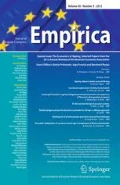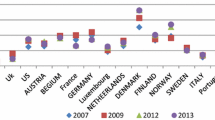Abstract
This paper deals with the effects of labour market institutions on unemployment in a panel of 19 OECD countries for the period 1960–2000. In contrast to many other studies, we use long time series and analyse cyclically adjusted trend values of the unemployment rate. Our novel contribution is the estimation of panel models where we allow for heterogeneous effects of institutions on unemployment. Our main results are, first, that on the average tighter employment protection, a higher tax burden on labour income and a more generous unemployment insurance system increase, whereas a higher centralization of wage negotiations decreases unemployment, and secondly, that the magnitude of the effects of institutions differs considerably between countries.



Similar content being viewed by others
Notes
For the period between 1985 and 2000, the correlation between the Allard indicator and the OECD indicator (Version 1) is 0.92. For Version 2 of the OECD indicator that in contrast to Version 1 is the weighted sum of the sub-indicators for regular and temporary contracts and collective dismissals the correlation amounts to 0.94. Version 2 is available only from 1998 onwards. The Labour Market Institutions Database of Nickell and Nunziata (2001) offers for the years from 1960 until 1995 another measure of the strictness of employment protection. This series was built chaining some OECD data with data from Lazear (1990) and has two drawbacks compared with the newer OECD or Allard data: Firstly, the authors often have to use the method of interpolation for many missing years. Secondly, the Lazear data is constructed on the basis of a less extensive collection of employment protection dimensions, compared with data used by the OECD. The correlation between the Nickell and Nunziata indicator and the OECD indicator (Version 1) for the years 1985 until 1995 is 0.82.
We call the heterogeneity not individual effects, but country effects in our article.
In the literature the name mixed models is often used for more elaborate random effects models as for example random coefficients models or multilevel linear models (Cameron and Trivedi 2005). Here we deviate from the literature and use for model 4 this name to express that this specification permits random as well as fixed effects.
We show here only the fixed effects estimates, because there are no relevant differences, like with the longer panel, between random effect and fixed effect estimation.
Again, we present only the fixed effects estimates, because there are no relevant differences between random effect and fixed effect estimation with cluster robust standard errors.
References
Allard G (2005a) Measuring job security over time: in search of a historical indicator for EPL (Employment Protection Legislation). IE working paper 05–17
Allard G (2005b) Measuring the changing generosity of unemployment benefits: beyond existing indicators. IE working paper 05–18
Baker D, Glyn A, Howell D, Schmitt J (2004) Unemployment and labor market institutions: the failure of the empirical case for deregulation. CEPA working paper 2004
Bartelsman EJ, De Wind J, Gautier PA (2010) Employment protection, technology choice, and worker allocation. CEPR discussion paper no 7806
Bassanini A, Duval R (2006) The determinants of unemployment across OECD Countries: reassessing the role of policies and institutions. OECD Econ Stud 42:7–86
Belot M, van Ours JC (2004) Does the recent success of some OECD Countries in lowering their unemployment rates lie in the clever design of their labour market reforms? Oxf Econ Pap 56:621–642
Bertola G, Blau FD, Kahn LM (2001) Comparative analysis of labor market outcomes: lessons for the US from international long-run evidence. NBER working paper, 8526
Blanchard O (2006) European unemployment. Econ Policy 45:5–47
Blanchard O, Wolfers J (2000) The role of shocks and institutions in the rise of european unemployment: the aggregate evidence. Econ J 110:C1–C33
Bode O, Fitzenberger B, Franz W (2008) The phillips curve and NAIRU revisited: new estimates for Germany. Jahrbücher für Nationalökonomie und Statistik 228(5+6):465–496
Caballero RJ, Cowan K, Engel EMRA, Micco A (2004) Effective labor regulations and microeconomic flexibility. MIT working paper no. 04–30
Cahuc P, Zylberberg A (2004) Labor economics. MIT Press, Cambridge
Calmfors L, Driffill J (1988) Bargaining structure, corporatism and macroeconomic performance. Econ Policy 6:14–61
Cameron AC, Trivedi PK (2005) Microeconometrics methods and applications. Cambridge University Press, Cambridge
Eichhorst W, Feil M, Braun C (2008) What have we learned? Assessing labor market institutions and indicators. IZA discussion paper no 3470
Flaig G, Rottmann H (2009) Labour market institutions and the employment intensity of output growth. Jahrbücher für Nationalökonomie und Statistik 229:22–35
Garcia JR, Sala H (2008) The tax system incidence on unemployment: a country-specific analysis for the OECD economies. Econ Model 25:1232–1245
Gomez-Salvador R, Messina J, Vallanti G (2004) Gross job flows and institutions in Europe. ECB working paper no. 318
Gordon RJ (1997) The time-varying NAIRU and its implications for economic policy. J Econ Perspect 11:11–32
Griffith R, Harrison R, Macartney G (2007) Product market reforms, labour market institutions and unemployment. Econ J 117:C142–C166
Hsiao C (2003) Analysis of panel data, 2nd edn. Cambridge University Press, Cambridge
Hunt J (1995) The impact of unemployment compensation on unemployment duration in Germany. J Labour Econ 13:88–120
IMF (1999) World economic outlook, May 1999, Chapter IV: chronic unemployment in the Euro area: causes and cures, pp 88–121
IMF (2003) World economic outlook, April 2003, Chapter IV: unemployment and labor market institutions: why reforms pay off, pp 129–150
Katz L, Meyer B (1990) The impact of potential duration of unemployment benefits on the duration of unemployment. J Public Econ 41:45–72
Koeniger W, Prat J (2007) Employment protection, product regulation and firm selection. Econ J 117:F302–F332
Lalive R, van Ours J, Zweimüller J (2006) How changes in financial incentives affect the duration of unemployment. Rev Econ Stud 73:1009–1038
Laubach T (2001) Measuring the NAIRU: evidence from seven countries. Rev Econ Stat 83:218–231
Layard R, Nickell S, Jackman R (2005) Unemployment. Macroeconomic performance and the labour market, 2nd edn. Oxford University Press, Oxford
Lazear E (1990) Job security provision and employment. Q J Econ 105:699–726
Lindbeck A (1993) Unemployment and macroeconomics. MIT Press, Cambridge
Lommerlund KE, Straume OR (2010) Employment protection versus flexicurity: on technology adoption in unionised firms. CEPR discussion paper no 7919
Messina J (2005) Institutions and service employment: a panel study for OECD countries. Labour 19:343–372
Nickell S (1997) Unemployment and labour market rigidities: Europe versus North America. J Econ Perspect 11:55–74
Nickell S (2003) Labour market institutions and unemployment in OECD countries. CESifo DICE Rep 1(2):13–26
Nickell S (2006) A picture of European unemployment: success and failure. In: Werding M (ed) Structural unemployment in western Europe. Reasons and remedies. MIT Press, Cambridge
Nickell S, Layard R (1999) Labour market institutions and economic performance. In: Ashenfelter O, Card D (eds) Handbook of Labor Economics, vol 3. North Holland, Amsterdam
Nickell S, Nunziata L (2001) Labour market institutions database (these data are attached to CEP discussion paper no. 502)
Nickell S, Nunziata L, Ochel W (2005) Unemployment in the OECD since the 1960 s. What do we Know? Econ J 115:1–27
Nickell W (2006) The CEP-OECD institutions data set (1960–2004). CEP discussion paper no 759
OECD (2004) OECD Employment outlook. Paris, pp 61–181
Phelps E (1994) Structural slumps: the modern equilibrium theory of unemployment. Interest and Assets. Harvard University Press, Cambridge
Pissarides CA (1998) The impact of employment tax cuts on unemployment and wages: the role of unemployment benefits and tax structure. Eur Econ Rev 47:155–183
Shapiro C, Stiglitz J (1984) Equilibrium unemployment as a worker discipline device. Am Econ Rev 74:433–444
Summers L (1989) Some simple economics of mandated benefits. Am Econ Rev 79:177–183
Visser J (2006) Union membership statistics in 24 countries. Mon Labour Rev 129:38–49
Zhou J (2007) Danish for all? Balancing flexibility with security: the flexicurity model. IMF working paper 07(36)
Acknowledgments
The research in this paper is part of the project “Zukunft der Arbeit”, sponsored by funds of the “Pact for Research and Innovation”. The financial support is gratefully acknowledged. We thank participants at seminars at the Universität der Bundeswehr (Hamburg), Universität Osnabrück, Institut für Zeitgeschichte, ifo Institut and the congress of the Verein für Socialpolitk for useful comments. Two referees provided very helpful suggestions for improving an earlier version of the paper.
Author information
Authors and Affiliations
Corresponding author
Rights and permissions
About this article
Cite this article
Flaig, G., Rottmann, H. Labour market institutions and unemployment: an international panel data analysis. Empirica 40, 635–654 (2013). https://doi.org/10.1007/s10663-012-9208-5
Accepted:
Published:
Issue Date:
DOI: https://doi.org/10.1007/s10663-012-9208-5




